Harsh
Well-Known Member
Could the problem be as simple as you need a 25, 27, or 28mm cpl instead of a 24mm cpl like you used?
You'll only have a bigger piece of glass, problem is the lens cap's diameter.
Could the problem be as simple as you need a 25, 27, or 28mm cpl instead of a 24mm cpl like you used?
You'll only have a bigger piece of glass, problem is the lens cap's diameter.
Oh, Cool! I only stumbled on it a few months ago.
I've always connected the M1 with the card removed.
Don't remember if it was here or the manual, first time I wanted to use webcam mode, read that the card needs to be removed for it to work, have always used it like that.
That is why the solution needs to come by using a different approach.You'll only have a bigger piece of glass, problem is the lens cap's diameter.



OK, I see that I did misunderstand your post. You mentioned my name and shifted the subject to slding filters in the following sentence. Well, perhaps I shouldn't be replying to posts at 5am.Nevertheless, since you questioned the notion of a sliding CPL design being knocked out of position from G forces in favor of a hinged design held in place by "friction" I brought up the fact that even a hinged design is just as likely to flip into or out of place if one is driving on bumpy roads.
Your logic about the severity of bumpy roads, "bump acceleration in a car" or lateral "G" forces and the like is rather amusingly provincial. It is wrong to assume that everyone else in the world is going to experience the same genteel driving conditions that you experience in the UK. As I've explained many times I reside in a mountainous rural area where I live on and drive on bumpy dirt roads every day. Depending upon the weather conditions, temperature, time of year and road crew maintenance schedule, the road conditions vary from tarmac like smoothness to rutted washboards, pot holes, gravel swales and deep mud along with all kinds of other road surface hazards such as deep packed ridges of ice and frozen snow. Dash cam vibration, shock and road impact has been a primary concern that I've had to contend with ever since I first became involved with these cameras. And many people around the world live in urban areas with large sections of poorly maintained roads full of potholes at every turn.
Each year, early Spring, we experience a phenomenon called "Mud Season" where the frost is working its way out of the ground, snow and rain are often falling and the roads turn into a hellish mess that then freezes solid every night only to melt the next day (or not). You want some bumps and lateral G forces while driving, you won't find better!This is in part why I drive a 4x4 truck with knobby M&S tires! And this is also why everything related to using dash cams in my vehicle needs to be as solid and secure as possible.
View attachment 41855
You'll only have a bigger piece of glass, problem is the lens cap's diameter.
That is why the solution needs to come by using a different approach.
Something like this approach is needed.
In this case we need an 18mm (approximately) slip on cpl filter adapter made something like this. It may need to be a different height to work in this application.


That way we can end up with something like this that bypasses the vignetting problem..

Is the encoding used a developer choice or is that built in based on the hardware used? While RC users might want longer battery life dashcam users do not really object when a camera uses a little more electricity if files of the same quality were smaller.The Maxi files are 1.3GB for 3 minutes at 60.1Mbps.
I have tried the next quality setting (2.7k Superfine 44Mbps) but the camera seems to lose detail through higher compression. Remember that at 2.7k the Maxi is using JPEG encoding rather than the more efficient AVC encoding, so bitrates and file sizes have to go up to maintain the same level of detail.
I was not referring to battery efficiency in relation to JPEG vs AVC. The Maxi chipset can only handle h264 (AVC) up to 1920x1080 resolution. However it can also process the higher 2704x1524 resolution (and interpolated 4k) using MJPEG, which is less efficient in terms of compression. That's why there is such a big jump in the bitrate from FHD to 2.7k.Is the encoding used a developer choice or is that built in based on the hardware used? While RC users might want longer battery life dashcam users do not really object when a camera uses a little more electricity if files of the same quality were smaller.
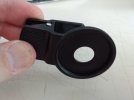
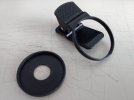

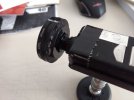
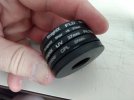

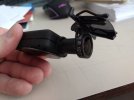
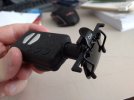
A sliding design will have to slide freely, so is more likely to be displaced than a hinge design where friction plays more of a part, and we certainly don't have genteel roads, ours are some of the worst in Europe, I'd say a lot worse than your urban roads, as even our urban ones are full of potholes. However, yes, your country back roads, are far worse than our tarmac ones!
Having said that, any design is going to be for masses. I doubt any manufacturer this side of someone like Jeep is going to purposely manufacture a system to withstand roads like the one pictured. Dashcam manufacturers are likely to aim for the majority of the world market which will be tarmac'ed smooth surfaces. Any design to withstand the roads you've pictured, is going to be a specialist off road brand's area or a DIY fix. On that, your own lens cap design is definitely going to fair best.
Here's a solution that works for me, made it in 20 minutes.
Adjusting the cpl filter is easy, look through the filter towards a led screen (that is ON....), turn the cpl filter as to a point where you can't see the screen anymore, it seems like the cpl glass gets black.
Then turn the top of the filter to the LEFT 45 degrees, mark the upper position, and you're done....! No need for "webcam-type-in-the-car-struggles"...
It ALWAYS works this way. Don't believe me? Take your polaroid sunglass and do the same towards the screen. Now compare, your sunglass is ALWAYS in ONE position (horizontal) on your nose.....(!) If you turn the top of your POLARIZED sunglass 45 degree to the RIGHT then you'll see the glass gets "black" as well. So, turning a polarized glass 45 degree left, should get you the most desirable position for your CPL filter. Try it in you car wearing your polarized sunglasses, look through the windscreen (on a sunny day..) turn your head vertically towards your shoulders, and see the glare appear and dissappear when turning back upwards.....
Take a flat rubber ring/washer of 20mm ID x 30mm OD and 3mm thick. Place the rubber over the lens, if it feels too loose, apply some thick tape and over-cut it in the hole, so that a small piece of the tape bends inward, tightening the lens fit more snug.
Then buy a phone lens adapter with 37mm screw mount and 37mm CPL filter, take out the metal holder out of the plastic ring, and there is your metallic 37mm cpl mount-base. Screw in your 37mm CPL filter, note the top marking you added, and you're good to go!
Use dual sided adhesive tape to mount your rubber ring to the round metallic mount (cutting out the hole of course), and your CPL filter is ready. Now a CPL filter is adjustible, and therefore there's a chance it may rattle while driving due to your car's vibrations. If it does, take a bicycle's defective innertube and cut 2 mm of it, and place it around the outer ring of the cpl holder, rattle gone.
Great bonus: you can now easily experiment with other 37 mm filters as well, like UV, STAR and FLD filters, you know, for filmic effects!!
You can add another rubber ring if you think the fixture isn't stable enough.
See pictures.
View attachment 41889View attachment 41888View attachment 41890View attachment 41891View attachment 41887
I've used the CPL holder before in another setup, took of that glue, so there's some residue there. You can use SUGRU (see picture) to further style/mold your mount in the shape you want, and make the holder more stable to the lens.
Apart from the glue residue from an earlier "job", that don't look shabby at all to me!
View attachment 41892
Nevertheless the solution with the SUN FLIPPIES (see picture) saves you a lot of work, because you ALREADY know the correct position for the glass, cause it's a sunglass..... top side is always, well, you know on top, also on your Mobius.
View attachment 41894View attachment 41893
But I also gotta be honest, I ALMOST NEVER use the CPLfilters......
OK, here's about 18 seconds into the clip the cpl comes off, you decide for yourself
surprisingly it looked better with it on, yes it's brighter with it off but all the lights are over blown which washes off some detail
